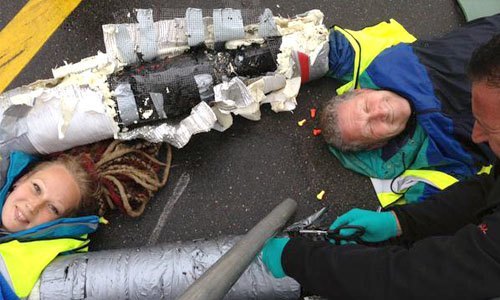
13 Flights Cancelled, 9 People Arrested as Climate Activists Protest Runway Expansion

Thirteen activists from the group Plane Stupid chained themselves together on the northern runway at the London Heathrow Airport in England this morning protesting the runway expansion saying, “We cannot meet our climate change targets and build new runways at the same time.”
Activists wore armlocks and laid on the runway, where police brought heavy machinery to cut them free, according to the Guardian.
The statement released this morning by Plane Stupid challenged the assumption that expanding Heathrow fits with the UK’s climate change goals and argued that “if the aviation industry paid more of its environmental costs then there would be no pressing need for a new runway.”
“Building more runways goes against everything we’re being told by scientists and experts on climate change,” said Ella Gilbert, an activist from Plane Stupid. “This would massively increase carbon emissions exactly when we need to massively reduce them, that’s why we’re here.
“We want to say sorry to anyone whose day we’ve ruined, and we’re not saying that everybody who wants to fly is a bad person. It’s those who fly frequently and unnecessarily who are driving the need for expansion, and we cannot keep ignoring the terrifying consequences of flying like there’s no tomorrow. No ifs, no buts, no third runway. And we mean it.”
Sarah Shoraka of Plane Stupid told the Guardian that the group re-formed since the release this month of a long-awaited report that recommended a new runway should be built at Heathrow to provide “urgently required” capacity.
“We thought we’d won this fight, because David Cameron said ‘no ifs, no buts’ there would be no runway at Heathrow,” Shoraka told the Guardian. “We thought it was off the table and then the report came through and we thought: ‘We’re going to have to fight this all over again.’”
“We need to insert climate change into the narrative, it’s been absent from the whole debate ever since the report came out,” she said.
According to Plane Stupid, the airport expansion is a terrible idea because:
- We cannot meet our climate change targets and build new runways at the same time. It’s a choice between the two. This should be very simple to understand.
- We already fly more than any other country per head.
- Nine of the ten most popular destinations out of Heathrow are short-haul including to places such as Manchester and Paris. There are already very good existing rail alternatives that we should be using instead.
- 15 percent of the UK population take 70 percent of the flights. Building new runways will only benefit rich frequent flyers who are burning the planet for unnecessary leisure flights.
- Airport expansion will have terrible implications for noise pollution and air pollution.
- Local communities face being wiped off the map entirely by a third runway at Heathrow.
- Aviation gets huge tax subsidies and pays no VAT. Why are we propping up an industry which is highly damaging to the environment at the exact time we need to be reducing our carbon emissions?
- The huge advertising budgets of the aviation industry have tricked the public into believing we face an airport capacity crisis.
- Additionally, the employment benefits of expansion have been overplayed. Claims that airport expansion will create thousands of new jobs are based on unreliable statistics. Airport expansion actually results in more UK tourists going abroad, which creates a “tourism deficit.”
YOU MIGHT ALSO LIKE
David Suzuki, Pope Francis and Dalai Lama All Agree: It’s Time to #ActOnClimate

 233k
233k  41k
41k  Subscribe
Subscribe 